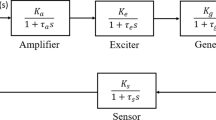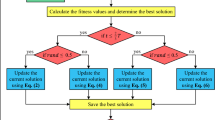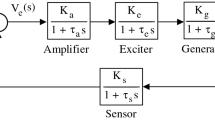Abstract
The design of the optimal controller with an appropriate setting of its parameters is very much essential for an automatic voltage regulator (AVR) system. Even though a lot of research has been undertaken in the past few decades, as no unanimously accepted methodology does not result yet, it is an open and very important field of research for designing an optimal controller for AVR. In this paper, an advanced version of the classical proportional-integral–differential (PID) control technique based on fractional calculus is designed titled as fractional order-PID control (FO-PID) controller for the AVR operation. The new strategy has been employed for computing the gain parameters of the controller unlike the conventional controller used generally in the real-time applications of an AVR. To enhance further the performance of FO-PID, a grasshopper evolutionary technique (GET) has been adapted for optimally setting the parameters for the enhanced performance of the controller. A comparative analysis of the proposed GET-FO-PID controller to justify its performance with conventional tuned PID controller using Ziegler–Nichols, Nelder Mead, and GET is presented and analyzed with. It has been demonstrated that the proposed approach produces a substantial improvement in the AVR system response with better controllability and stability. To justify the performance of the proposed GET-FO-PID controller including the AVR, time-domain analysis is also presented through MATLAB simulation.
Access this chapter
Tax calculation will be finalised at checkout
Purchases are for personal use only
Similar content being viewed by others
References
Kundur PS (2017) Power system stability. In Power system stability and control. CRC Press, pp 8–1
Khalid A, Shahid AH, Zeb K, Ali A, Haider A (2016) Comparative assessment of classical and adaptive controllers for Automatic Voltage Regulator. In: 2016 international conference on advanced mechatronic systems (ICAMechS), pp 538–543. IEEE
Sahu BK, Panda S, Mohanty PK, Mishra N (2012) Robust analysis and design of PID controlled AVR system using Pattern Search algorithm. In: 2012 IEEE international conference on power electronics, drives and energy systems (PEDES), pp 1–6. IEEE
Gaing ZL (2004) A particle swarm optimization approach for optimum design of PID controller in AVR system. IEEE Trans Energy Convers 19(2):384–391
Mukherjee V, Ghoshal SP (2007) Intelligent particle swarm optimized fuzzy PID controller for AVR system. Electr Power Syst Res 77(12):1689–1698
Hang CC, Åström KJ, Ho WK (1991) Refinements of the Ziegler–Nichols tuning formula. In: IEE Proceedings D (Control Theory and Applications), vol 138, No 2, pp 111–118. IET Digital Library.
Nelder JA, Mead R (1965) A simplex method for function minimization. Comput J 7(4):308–313
Podlubny I (1999) Fractional-order systems and PI/sup/spl lambda//D/sup/spl mu//-controllers. IEEE Trans Autom Control 44(1):208–214
Åström KJ, Hägglund T (2001) The future of PID control. Control Eng Pract 9(11):1163–1175
Tepljakov A, Alagoz BB, Yeroglu C, Gonzalez E, HosseinNia SH, Petlenkov E (2018) FOPID controllers and their industrial applications: a survey of recent results. IFAC-PapersOnLine 51(4):25–30
Saremi S, Mirjalili S, Lewis A (2017) Grasshopper optimisation algorithm: theory and application. Adv Eng Softw 105:30–47
Tripathy MC, Biswas K, Sen S (2013) A design example of a fractional-order Kerwin–Huelsman–Newcomb biquad filter with two fractional capacitors of different order. Circuits Syst Signal Proces 32(4):1523–1536
Mafarja M, Aljarah I, Heidari AA, Hammouri AI, Faris H, Ala’M AZ, Mirjalili S (2018) Evolutionary population dynamics and grasshopper optimization approaches for feature selection problems. Knowl Based Syst 145:25–45
Hekimoğlu B, Ekinci S (2018) Grasshopper optimization algorithm for automatic voltage regulator system. In: 2018 5th international conference on electrical and electronic engineering (ICEEE), pp 152–156. IEEE
Dulău M, Gligor A, Dulău TM (2017) Fractional order controllers versus integer order controllers. Procedia Eng 181:538–545
Duman S, Yörükeren N, Altaş IH (2016) Gravitational search algorithm for determining controller parameters in an automatic voltage regulator system. Turkish J Electr Eng Comput Sci 24(4):2387–2400
Valério D, Da Costa JS (2006) Tuning of fractional PID controllers with Ziegler–Nichols-type rules. Signal Proces 86(10):2771–2784
Baig WM, Hou Z, Ijaz S (2017) Fractional order controller design for a semi-active suspension system using nelder-mead optimization. In 2017 29th Chinese Control And Decision Conference (CCDC), pp 2808–2813. IEEE
Ewees AA, Elaziz MA, Houssein EH (2018) Improved grasshopper optimization algorithm using opposition-based learning. Expert Syst Appl 112:156–172
Almugren N, Alshamlan H (2019) A survey on hybrid feature selection methods in microarray gene expression data for cancer classification. IEEE Access 7:78533–78548
Basu A, Mohanty S, Sharma R (2017) Tuning of FOPID controller for meliorating the performance of the heating furnace using conventional tuning and optimization technique. Int J Electr Eng Res 9(1):69–85
Guha D, Roy PK, Banerjee S (2019) Grasshopper optimization algorithm-scaled fractional-order PI-D controller applied to reduced-order model of load frequency control system. Int J Model Simul 1–26
Author information
Authors and Affiliations
Corresponding author
Editor information
Editors and Affiliations
Rights and permissions
Copyright information
© 2021 The Editor(s) (if applicable) and The Author(s), under exclusive license to Springer Nature Singapore Pte Ltd.
About this paper
Cite this paper
Biswal, S.S., Swain, D.R., Rout, P.K. (2021). Improving the Performance of AVR System Using Grasshopper Evolutionary Technique. In: Sharma, R., Mishra, M., Nayak, J., Naik, B., Pelusi, D. (eds) Green Technology for Smart City and Society. Lecture Notes in Networks and Systems, vol 151. Springer, Singapore. https://doi.org/10.1007/978-981-15-8218-9_34
Download citation
DOI: https://doi.org/10.1007/978-981-15-8218-9_34
Published:
Publisher Name: Springer, Singapore
Print ISBN: 978-981-15-8217-2
Online ISBN: 978-981-15-8218-9
eBook Packages: Intelligent Technologies and RoboticsIntelligent Technologies and Robotics (R0)




